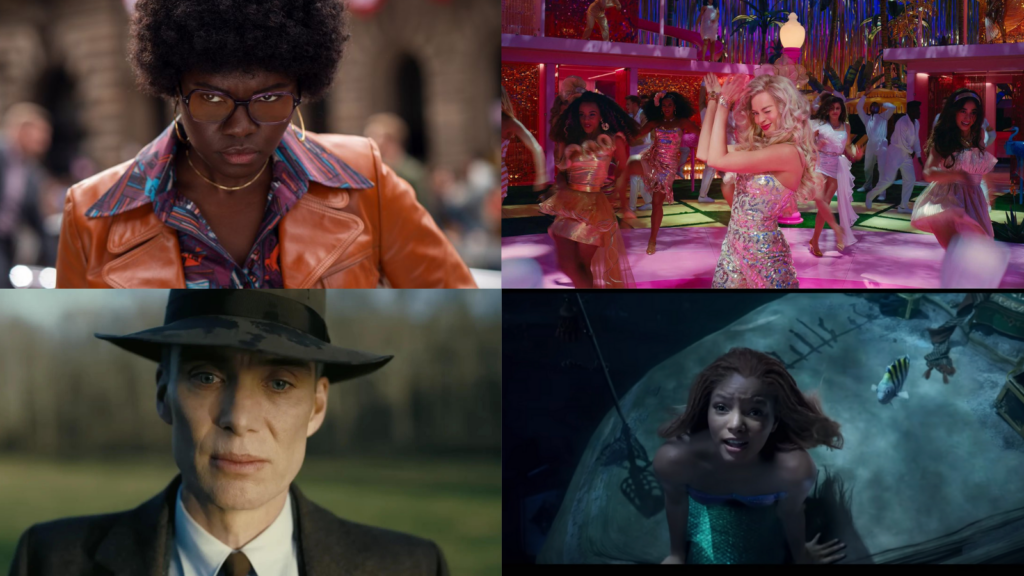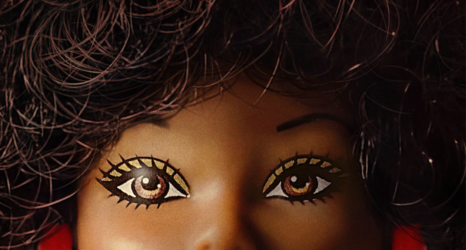Let’s hope Barbie’s commercial success encourages more support for films that feature diverse women as big-screen heroes. There are so many more stories to be told.

Note: Spoilers to follow.
I love watching movies on the big screen. I’m such a cinephile that I was one of the few who headed straight to the movie theaters during the pandemic once they finally opened (albeit with my mask on during near-empty matinee viewings). So, it’s good to see more of us entering theaters once again, despite all of our many movie choices via streaming.
Despite this love for larger-than-life motion pictures, I must also lament the dearth of images of Black women in heroic, star-turning roles.
For this reason, I was more than willing to support Halle Bailey’s turn as Ariel, the titular Little Mermaid, when the Disney live-action remake kicked off this summer’s blockbuster season. This groundbreaking casting did not disappoint, as Halle Bailey delivered a flawless version of the iconic “Part of Your World,” and the movie did impressive numbers despite racist, misogynistic and misogynoir-istic efforts to undermine its success—so disturbed were some at the sight of a Black mermaid with dreadlocks. Imagine that a scientist even went out of his way to alter the actor’s racial appearance by literally whitewashing her through AI alteration—all while keeping Halle’s ethereal voice. How typical: Render us invisible but exploit our talent.
What does revisiting the controversies surrounding The Little Mermaid have to do with current summer blockbuster fare? The racist complaints against Halle Bailey are a failure of imagination, which is the work of a limited white supremacist and heteropatriarchal worldview. Such conversations display their ignorance of African-based tales of Black mermaids, orishas and goddesses. More, they demonstrate an outdated view of the world—just as we are being tasked to rethink and reimagine our planet and its future, especially one teeming with Black women and girls.
We are in need of a Black feminist imagination.
What Our Heroes Look Like
Some of our summer franchises would prefer that such women not exist—or only exist in the margins. The Black woman is rarely seen as a hero on the big screen.
- In the latest Indiana Jones reboot, the sole Black character, played by Shaunette Renée Wilson, is quickly disposed of. (Predictable, given the tagline joke in this summer’s The Blackening: “We can’t all die first.)
- In the latest Mission: Impossible, she doesn’t exist at all. Indeed, it is more than telling how studio films still rely on white male heroes, no matter how old, to bring in audiences, even if they tease reverse-aging AI tech on octogenarian actors like Harrison Ford. No wonder SAG members are on strike over this impending menace!
If the Tom Cruises and Harrison Fords are the only “heroes” trusted at the box office, then what of the potential of seeing actors like Lupita Nyong’o, who is more than worthy to have her own spy franchise (based on her war dog character Nakia in Black Panther) or even Lashana Lynch, named in the last James Bond movie as the new 007? Some audiences balk at the thought of Idris Elba playing the next James Bond, let alone someone of a different gender. But again, these controversies—much like The Little Mermaid—are a failure of imagination.
The Black woman is rarely seen as a hero on the big screen.
Which brings me to the latest summer movies. Much has been made of audiences combining their interests in seeing Greta Gerwig’s Barbie (starring Margot Robbie) and Christopher Nolan’s Oppenheimer (starring Cillian Murphy), both opening the same weekend.
Being the cinephile that I am, I opted to do the recommended “double feature” of “Barbenheimer,” which inevitably led to comparisons of these aesthetically diametrically opposed films: one based on the toxic masculinity of the atomic age, the other based on the equally toxic (for some) femininity of the iconic Barbie doll.
Environmental studies scholar Tyler Austin Harper reminded us how both titular heroes have more in common in defining our Anthropocene age: Consider how J. Robert Oppenheimer’s invention of the atomic bomb ushered in the plutonic age, while the Barbie doll accelerated the mass consumption of plastic—both materials now posing serious dangers to our planet.
The Atomic Bomb at the Movies
I would like to extend this critique with a discussion of the imagination. Oppenheimer’s moment in history is not just defined by nuclear power and consumerism. The same horrifying stories of Jewish and Roma victims at Nazi death camps—which propelled Oppenheimer and his fellow Jewish recruits to conspire with the U.S. military in the making of the atomic bomb to defeat Germany—also inspired the non-West to throw off the shackles of Western imperialism. African Americans utilized the United States’ status as a global superpower to advance the civil rights movement. The violent assertions of white supremacy merely led to its impending demise, once communities and nations of color imagined a new world beyond whiteness.
Interestingly, Nolan does not tell the story of Oppenheimer beyond whiteness. He may have explored his hero’s womanizing, his left-leaning political views and even his “diverse” classroom. (One of his pupils included the only Black woman in the film—perhaps a nod to those African Americans who also worked on the Manhattan Project, such as Carolyn Beatrice Parker, whose biography is analyzed by Black feminist astrophysicist Chanda Prescod-Weinstein.)
But Nolan adheres to a “gentilized” narrative that frames the Manhattan Project as a predominately white-male affair of the dangers of intellectual genius being exploited by the military-industrial complex.
For a film that entertains us with many POV shots of Oppenheimer—from his horror-filled gaze at the first ignition of the atomic bomb, to his lust-filled view of his nude tortured girlfriend, played by Florence Pugh—Nolan fails to show us what Oppenheimer regretfully witnesses while watching a film describing the devastating impact on the victims of Hiroshima. Such omissions contribute to the historical erasure of the different communities of color: not just the quarter of a million victims at Hiroshima and Nagasaki in Japan, but also the Native American and Hispanic communities who were displaced at Los Alamos in New Mexico, and the continued testing of nuclear weapons on the Marshall Islands, which has devastated generations of local communities still feeling the effects of radioactive exposure.
Framing the camera’s gaze for a predominately white male narrative reinforces a gendered and racialized hierarchy that renders the rest of the world as mere chess pieces—as demonstrated by a military officer in Nolan’s film flippantly taking Kyoto off the table for the bomb drop, because he and his wife enjoy vacationing there.
The violent assertions of white supremacy merely led to its impending demise, once communities and nations of color imagined a new world beyond whiteness.
Enter Barbieland
But if war and empire-building are a game for those in power, no wonder toys are so important for the next generation to exercise their imagination. Enter Barbie, and the movie Barbie, which allows filmmaker Gerwig to play with life-size dolls.
In her reimagined “Barbieland,” Margot Robbie as Stereotypical Barbie leads her fellow Barbies and all the Kens, but she’s so idealized in her white femininity that she knows not to be the one with political power. The honor of being president of Barbieland goes to Black Barbie, played humorously by Issa Rae.
At least in this topsy-turvy world where women run things—in contrast to the “real world” of patriarchy—we can imagine women in every possible role. Even here, though, Ken (played brilliantly by Ryan Gosling) manages to infuse his version of male rule once he gets a taste of it in the real world.
Fortunately for these Barbies, the Kens can only imagine horses as their “men-extensions” instead of guns and atomic bombs. However, there’s something to be said that Stereotypical Barbie, when confronted with the absurdity of toxic masculinity, responds helplessly like a lifeless doll. She is only animated literally by the consciousness of women of color (played by America Ferrara and Ariana Greenblatt, who plays Ferrara’s daughter Sasha). Ferrara’s character Gloria specifically compares the Kens’ patriarchal takeover to the historic moment when Native American matriarchal communities were demolished by white settler-colonialism—a sly reminder that white feminism owes a great deal to women of color feminism (be it symbolic leadership, historic examples or consciousness-raising).
Of course, Barbie’s all-inclusive casting—people of color, queer actors and a trans actor—already makes it a much more progressive film in comparison to Oppenheimer. (It even gives a nod to the Black mermaid Barbie doll inspired by Halle Bailey in the end credits!) But its power lies in its imagination.
An Inclusive Imagination
Oppenheimer ends on a note of despair—prophesying the destruction our hero has unleashed on the world—but Barbie brings back the doll’s creator Ruth Handler (played by Rhea Perlman) to urge Barbie beyond her plastic beginnings to embrace her full womanhood. Her initial fear of death simply opened up a new portal to a new life.
And this is where the two films merge.
In Oppenheimer, there’s a powerful scene depicting Oppenheimer listening to music and taking in art, which opens up his consciousness to interpret quantum physics and the dark matter of the universe. An imagination unleashed can create new ideas and new consciousness, but what if the imagination is limited by an egotistical doomsday view: “I am become death, the destroyer of worlds?”
Barbie shows—through Ruth Handler (a Jewish manufacturer who created the doll, named for her daughter, by coopting a German Aryan sex doll in the interest of shaping a three-dimensional vision of her daughter’s paper dolls to help her imagine a life beyond heteronormative scripts)—that our creations can have more life and more humanity when we subvert tools and convert them for good. It’s that Goddess energy: “I am become life, the creator of new worlds.”
Imagine, like Barbie’s creator, standing still and watching daughters advance as far as they can go! Imagine that—as the movie’s opening, wittily narrated by Helen Mirren, illuminates—this “goddess” energy does not have to rely solely on motherhood.
Such imagination can certainly fuel success, as Barbie’s weekend debut has already broken records as the first movie helmed by a woman director to score huge numbers at the domestic box office. That it has become the highest-grossing movie of 2023 thus far is a delightful rebuke to the traditional studios that insist on white male heroes for blockbuster success. Let us hope Barbie’s commercial success, as with the success of the racially diverse Spiderman: Across the Spider-Verse, encourages more support for films that feature diverse women as big-screen heroes.
There are so many more stories to be told for both big (and smaller) screens, fueled by an imagination that dares to be feminist and inclusive.
Up next:
U.S. democracy is at a dangerous inflection point—from the demise of abortion rights, to a lack of pay equity and parental leave, to skyrocketing maternal mortality, and attacks on trans health. Left unchecked, these crises will lead to wider gaps in political participation and representation. For 50 years, Ms. has been forging feminist journalism—reporting, rebelling and truth-telling from the front-lines, championing the Equal Rights Amendment, and centering the stories of those most impacted. With all that’s at stake for equality, we are redoubling our commitment for the next 50 years. In turn, we need your help, Support Ms. today with a donation—any amount that is meaningful to you. For as little as $5 each month, you’ll receive the print magazine along with our e-newsletters, action alerts, and invitations to Ms. Studios events and podcasts. We are grateful for your loyalty and ferocity.





